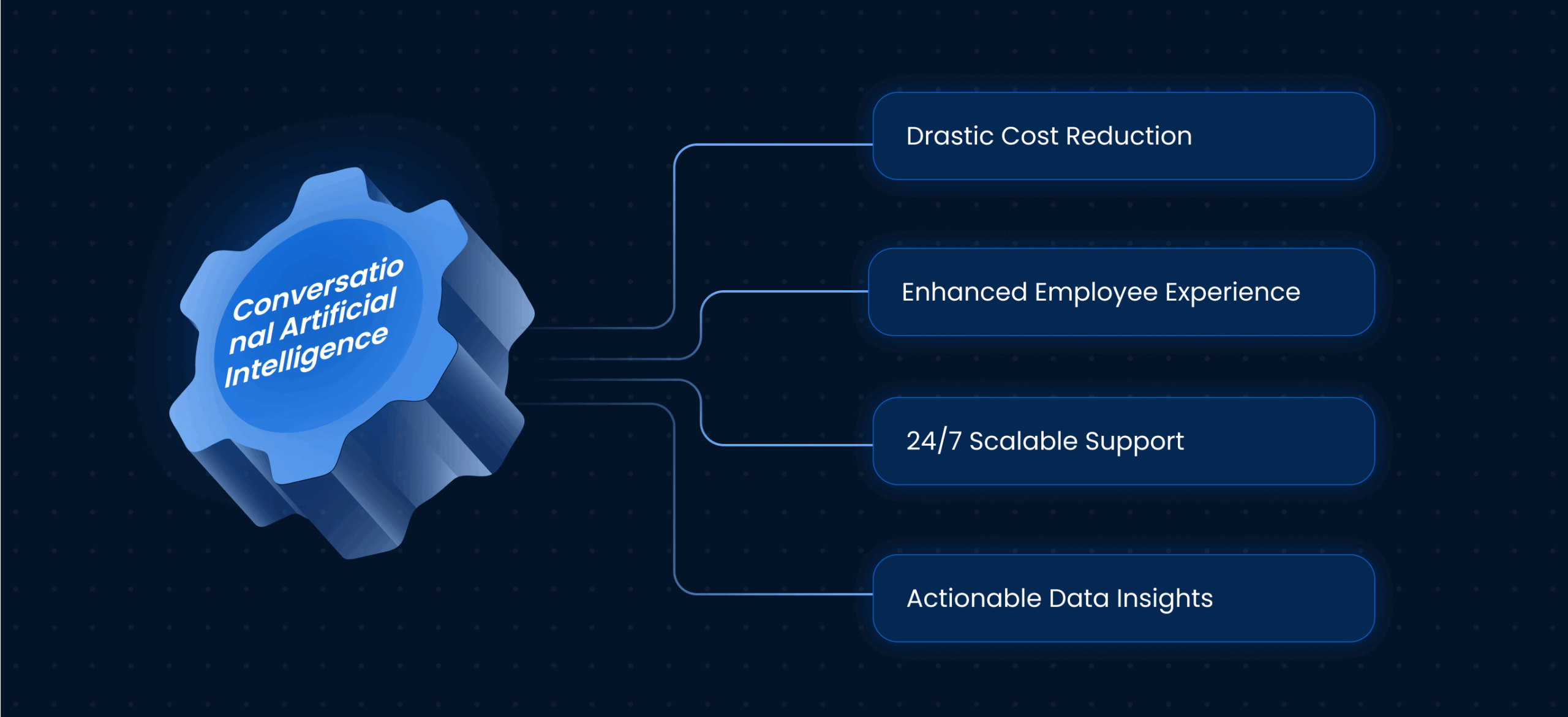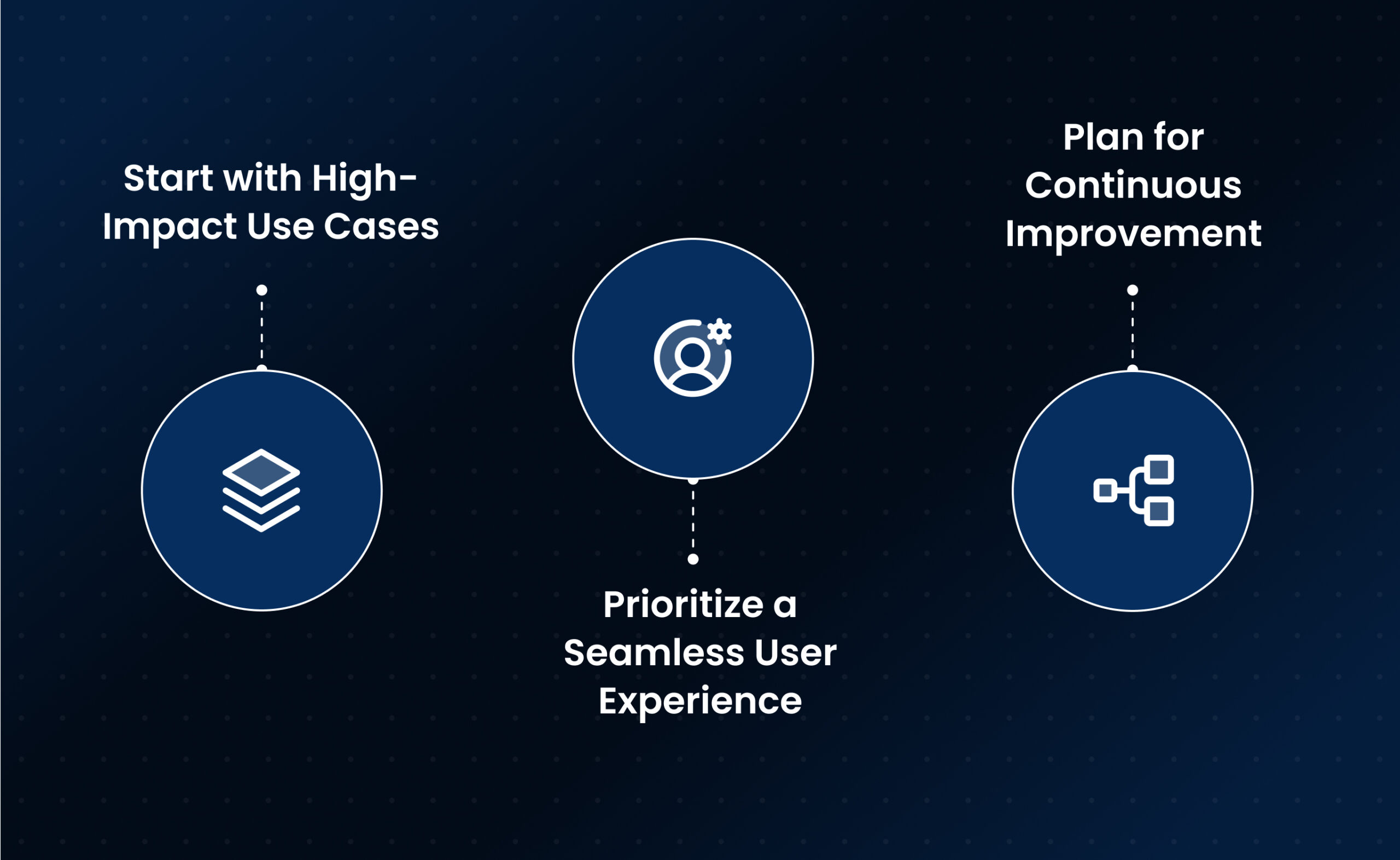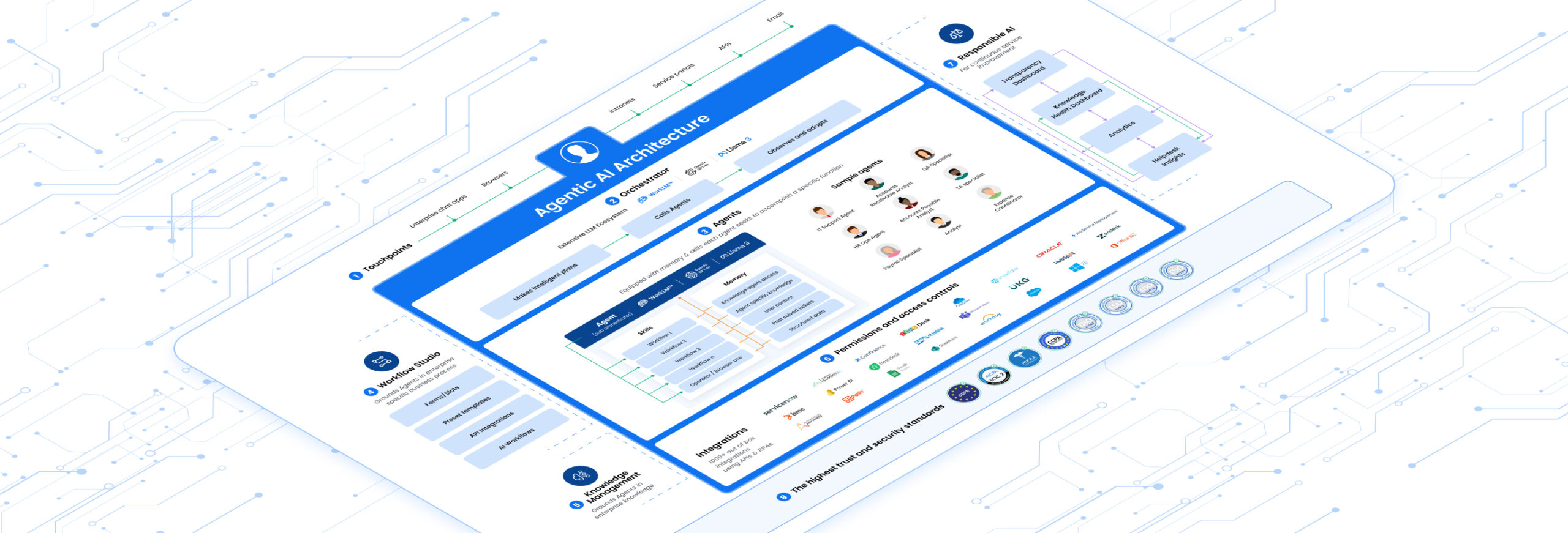Introduction
Your employees are busy. When they hit a roadblock, whether it’s a password issue, a payroll question, or a software request, they need a fast, effective solution. For years, the answer has been a ticketing system, but that often leads to long wait times and frustrated teams. Today, there’s a more powerful solution. We’re talking about conversational artificial intelligence, a technology that’s moving beyond simple chatbots to become a core driver of enterprise efficiency and employee satisfaction.
As a technology leader, you’re constantly evaluating how to best leverage innovation to drive business outcomes. This guide cuts through the noise to give you a clear, strategic overview of conversational artificial intelligence: what it is, how it creates value, and where it’s headed by 2025. We’ll explore how this technology is becoming the key to unlocking a truly seamless support experience for your entire organization.
Understanding Conversational Artificial Intelligence
This isn’t just another term for a chatbot. True conversational artificial intelligence represents a significant leap forward, creating systems that can understand, process, and respond to human language in a way that is both natural and contextually aware.
What is Conversational Artificial Intelligence?
At its heart, conversational artificial intelligence is technology that allows humans to interact with computers using natural language, much like you’d talk to another person. Think of the difference between a static FAQ page and a highly skilled support agent. The FAQ page provides fixed answers to fixed questions. In contrast, the support agent listens, understands the underlying issue even if it’s poorly phrased, asks clarifying questions, and provides a tailored solution. Modern conversational artificial intelligence aims to replicate that intelligent, two-way interaction at scale.
How Conversational Artificial Intelligence Works
The magic behind this technology lies in a few core components working together seamlessly.
-
Natural Language Understanding (NLU): This is the system’s “ears.” NLU’s job is to decipher the user’s intent. For instance, it understands that “My laptop won’t start” and “I can’t get my computer to turn on” both mean the same thing. It looks past the specific words to grasp the actual problem.
-
Dialogue Management: This is the “brain” of the operation. After understanding the intent, this component decides what to do next. It manages the flow of the conversation, remembers previous statements, and asks for more information when needed. For example, if a user asks to reset a password, it knows to ask “For which application?” before proceeding.
-
Natural Language Generation (NLG): This is the system’s “mouth.” Once a solution or response is determined, NLG constructs a grammatically correct, human-sounding reply. Instead of a robotic “PASSWORD RESET,” it might say, “Sure, I can help with that. I’ve just sent a secure password reset link to your registered email address.”
The Strategic Impact of Conversational Artificial Intelligence on Your Enterprise
Deploying a sophisticated conversational artificial intelligence platform is not just an IT upgrade; it’s a strategic business decision that delivers measurable results across the organization.
Key Use Cases of Conversational Artificial Intelligence
While the applications are vast, large enterprises are seeing the most significant impact in internal support functions, where high-volume, repetitive queries are common.
- IT Service Desk Automation: Instantly resolve common issues like password resets, software access requests, VPN troubleshooting, and hardware inquiries. Consequently, this frees up your skilled IT staff to focus on complex, high-value projects.
- HR and People Operations: Provide employees with 24/7 access to information about benefits, company policies, and paid time off. The system can also guide them through processes like onboarding or submitting a leave request.
- Finance Department Support: Immediately answer questions about expense report status, invoice processing, and payroll information. This reduces the administrative burden on your finance team.
Benefits of Implementing Conversational Artificial Intelligence
The “why” behind this technology is compelling, especially for leaders focused on the bottom line and operational excellence.
- Drastic Cost Reduction: By automating the resolution of up to 70% of common tickets, conversational artificial intelligence significantly lowers your cost per ticket and reduces the need to scale your support headcount.
- Enhanced Employee Experience: Employees get instant, accurate answers anytime, anywhere. This eliminates frustrating wait times and allows them to get back to their work faster, which directly boosts productivity and morale.
- 24/7 Scalable Support: The system works around the clock and across time zones, effortlessly handling fluctuating query volumes without a drop in performance.
- Actionable Data Insights: Every interaction is a data point. Sophisticated conversational artificial intelligence platforms can analyze thousands of conversations to spot recurring issues, identify gaps in your knowledge base, and provide valuable feedback to improve your services.

Navigating the Landscape of Conversational Artificial Intelligence
Like any powerful technology, a successful implementation requires a clear understanding of both the potential hurdles and the best practices for overcoming them. A well-planned approach to conversational artificial intelligence is essential for success.
Challenges and Limitations of Conversational Artificial Intelligence
Being aware of the potential challenges is the first step toward a successful deployment.
- Complex Integrations: For an AI to be truly useful, it must connect securely with your existing systems of record, like ServiceNow, Workday, or Salesforce. This requires robust integration capabilities.
- Data Security and Privacy: Handling employee data requires the highest level of security. Therefore, you must ensure the platform has enterprise-grade security protocols and compliance certifications.
- Maintaining Context: Handling complex, multi-turn conversations where the topic might shift requires a sophisticated dialogue management system to avoid a frustrating user experience.
Best Practices for Building Conversational Artificial Intelligence Systems
To maximize your return on investment, consider these key principles.
- Start with High-Impact Use Cases: Begin by identifying the most frequent and repetitive queries that are currently bogging down your support teams. Quick wins build momentum for the project.
- Prioritize a Seamless User Experience: The goal is to make getting help as easy as talking to a colleague. The interface should be intuitive and accessible within the platforms your employees already use, like Slack or Microsoft Teams.
- Plan for Continuous Improvement: A great conversational artificial intelligence system learns and evolves. Choose a platform that uses machine learning to get smarter over time and provides analytics to help you improve its performance.

The Next Frontier of Conversational Artificial Intelligence
The field of conversational artificial intelligence is evolving at a breakneck pace. Looking toward 2025, we’re moving from systems that answer to systems that act.
The Future of Conversational Artificial Intelligence
The next generation of this technology is defined by proactive, autonomous action.
- Proactive and Predictive Support: The future is not about waiting for a ticket. Instead, AI will analyze system data to anticipate a user’s problem and proactively offer a solution before they even ask.
- Hyper-Personalization: The AI will know an employee’s role, location, and past issues, allowing it to provide a support experience that is completely tailored to their individual context.
- Generative AI for Autonomous Resolution: Powered by advanced language models, the AI won’t just find a knowledge base article, it will perform the task. This includes writing a script to fix a software bug, executing an approval workflow, or provisioning a new cloud resource on the user’s behalf.
Leena AI and the Evolution of Conversational Artificial Intelligence
At Leena AI, we are at the forefront of this evolution with our focus on Agentic AI. This isn’t just conversational artificial intelligence; it’s an AI that acts as an autonomous agent, a true digital teammate for your employees.
Our platform is purpose-built for the enterprise, moving beyond simple chat to provide end-to-end resolution. Imagine an employee needs access to a specific application. Instead of just pointing them to a form, Leena AI’s agent understands the request, checks for manager approval, integrates with your identity management system, provisions the license, and notifies the employee once it’s done. This is the power of an AI that doesn’t just talk, it does. By taking on these multi-step, complex tasks, we deliver a truly frictionless workplace and unlock unprecedented levels of efficiency.
Conclusion
Conversational artificial intelligence has matured from a novel concept into an essential component of the modern enterprise technology stack. For CIOs and technology leaders, it offers a clear path to reducing operational costs, enhancing employee productivity, and future-proofing your support infrastructure. By embracing this technology, you can transform your internal support from a cost center into a strategic enabler of business success.
The Next Frontier of Conversational Artificial Intelligence
The field of conversational artificial intelligence is evolving at a breakneck pace. Looking toward 2025, we’re moving from systems that answer to systems that act.
The Future of Conversational Artificial Intelligence
The next generation of this technology is defined by proactive, autonomous action.
- Proactive and Predictive Support: The future is not about waiting for a ticket. Instead, AI will analyze system data to anticipate a user’s problem and proactively offer a solution before they even ask.
- Hyper-Personalization: The AI will know an employee’s role, location, and past issues, allowing it to provide a support experience that is completely tailored to their individual context.
- Generative AI for Autonomous Resolution: Powered by advanced language models, the AI won’t just find a knowledge base article, it will perform the task. This includes writing a script to fix a software bug, executing an approval workflow, or provisioning a new cloud resource on the user’s behalf.
Leena AI and the Evolution of Conversational Artificial Intelligence
At Leena AI, we are at the forefront of this evolution with our focus on Agentic AI. This isn’t just conversational artificial intelligence; it’s an AI that acts as an autonomous agent, a true digital teammate for your employees.
Our platform is purpose-built for the enterprise, moving beyond simple chat to provide end-to-end resolution. Imagine an employee needs access to a specific application. Instead of just pointing them to a form, Leena AI’s agent understands the request, checks for manager approval, integrates with your identity management system, provisions the license, and notifies the employee once it’s done. This is the power of an AI that doesn’t just talk, it does. By taking on these multi-step, complex tasks, we deliver a truly frictionless workplace and unlock unprecedented levels of efficiency.
Conclusion
Conversational artificial intelligence has matured from a novel concept into an essential component of the modern enterprise technology stack. For CIOs and technology leaders, it offers a clear path to reducing operational costs, enhancing employee productivity, and future-proofing your support infrastructure. By embracing this technology, you can transform your internal support from a cost center into a strategic enabler of business success.













